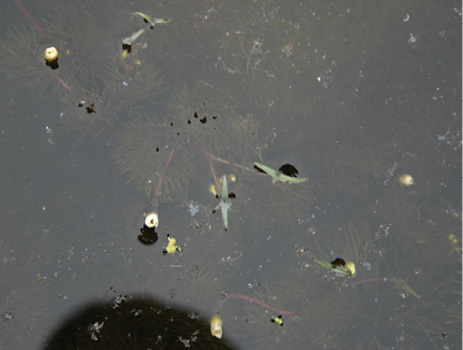Fanwort | Cabomba spp.
Submersed | Native



Fanwort is a rooted submerged plant with leaves that usually grow opposite on the stems, but sometimes are whorled. Submerged leaves are thread-like, somewhat flattened, and are finely dissected to form a characteristic fan shape, usually 0.5 to 1.3 inches wide. Floating leaves may occur in the uppermost leaf axis on the stem. They are narrow and nearly diamond shaped, and about 0.5 to .75 inch long.
Stems are slender and may be covered with a thin slime. The roots are fibrous and silvery. Fanwort features small flowers that are white to pinkish with yellow centers. They are attached to the same upper leaf axis as the floating leaves, and are less than half an inch wide.
Fanwort is abundant in ponds, lakes, and slow-flowing streams and rivers. However, it does not tolerate a wide range of physical and chemical factors.
Fanwort seldom causes any problems in recreational fishing ponds. It generally cannot establish where grass carp are present.
Management Value
Fanwort is rarely a problem species, yet it has little known value as a food for wildlife. It may be used by invertebrates that in turn feed fish, but, overall, it is not a particularly useful species in pond management.
Recommended Controls
Option 1: Endothall (4.23-pound formulation). Endothall (3.2 gallons per acre-foot of water) should be applied as a submersed injection (subsurface application using a wand or hose). Determine pond volume prior to application. Do not exceed annual herbicide rate limits as stated on the product label.
Option 2: Flumioxazin (4.0-pound formulation). Flumioxazin should be applied as a submersed injection (2.1 pints per acre-foot of water). Determine pond volume prior to application. When mixing with water with pH greater than 7.0, use a buffering agent. Do not exceed annual herbicide rate limits as stated on the product label.
Option 3: Carfentrazone-ethyl (1.9-pound formulation). Carfentrazone-ethyl should be applied as a submersed injection (42.6 ounces per acre-foot of water). Determine pond volume prior to application. Do not exceed annual herbicide rate limits as stated on the product label.
Option 4: Triclopyr (3.0-pound formulation). Triclopyr should be applied as a submersed injection (2.3 gallons per acre-foot of water). Determine pond volume prior to application. Do not exceed annual herbicide rate limits as stated on the product label.
NOTE: Acre-foot = average depth of pond multiplied by pond acreage; average depth is calculated by taking the depth at 20 points across a water body and averaging the values.
Treat ponds when the water temperature is at least 60˚F and the plants are actively growing. It is best to treat one-third of the pond at a time for larger water bodies, with two weeks or more separating applications. After the entire pond has been treated, a repeat whole-pond application may be necessary to eliminate remaining plants.
Option 5: Triploid Grass Carp. Carp will eat cabomba, but it is not a preferred food item. However, if no other food is available, stocking 10–15 fish per acre may provide control when herbicides are not an option. Stock 8- to 10-inch triploid grass carp in ponds that have established largemouth bass populations to avoid predation by bass. Note that abundant grass carp can impact other fish and can live up to 20 years.
If herbicides are used to control fanwort, consider stocking three to five triploid grass carp per acre to prevent re-infestation. Stock 8- to 10-inch triploid grass carp in ponds that have established largemouth bass populations to avoid predation by bass.
Read and follow all chemical label instructions, especially the section on the use of personal protection equipment.
Photo Credits Top: Leslie J. Mehrhoff, University of Connecticut, Bugwood.org; Bottom: Leslie J. Mehrhoff, University of Connecticut, Bugwood.org.

The information given here is for educational purposes only. References to commercial products, trade names, or suppliers are made with the understanding that no endorsement is implied and that no discrimination against other products or suppliers is intended.
Publication 3735-8 (POD-11-23)
By Wes Neal, PhD, Extension/Research Professor, Wildlife, Fisheries, and Aquaculture; Dennis Riecke, Fisheries Coordinator, Mississippi Department of Wildlife, Fisheries, and Parks; and Gray Turnage, PhD, Assistant Research/Extension Professor, GeoSystems Research Institute.
The Mississippi State University Extension Service is working to ensure all web content is accessible to all users. If you need assistance accessing any of our content, please email the webteam or call 662-325-2262.



